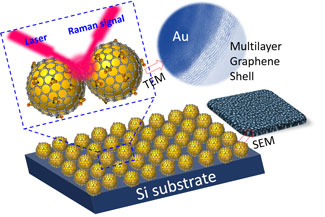Crossref Citations
This article has been cited by the following publications. This list is generated based on data provided by
Crossref.
Liu, Heguang
Li, Yuan
Dykes, John
Gilliam, Todd
Burnham, Kelly
and
Chopra, Nitin
2018.
Manipulating the functionalization surface of graphene-encapsulated gold nanoparticles with single-walled carbon nanotubes for SERS sensing.
Carbon,
Vol. 140,
Issue. ,
p.
306.
Pallares, Roger M.
Thanh, Nguyen Thi Kim
and
Su, Xiaodi
2019.
Sensing of circulating cancer biomarkers with metal nanoparticles.
Nanoscale,
Vol. 11,
Issue. 46,
p.
22152.
Ananthoju, Balakrishna
Biroju, Ravi K.
Theis, Wolfgang
and
Dryfe, Robert A. W.
2019.
Controlled Electrodeposition of Gold on Graphene: Maximization of the Defect‐Enhanced Raman Scattering Response.
Small,
Vol. 15,
Issue. 48,
Hu, Yuan
López-Lorente, Ángela I.
and
Mizaikoff, Boris
2019.
Graphene-Based Surface Enhanced Vibrational Spectroscopy: Recent Developments, Challenges, and Applications.
ACS Photonics,
Vol. 6,
Issue. 9,
p.
2182.
Liu, Heguang
Xu, Yadong
Li, Yuan
and
Chopra, Nitin
2019.
Controlled thermal shrinking of gold nanoparticle-decorated polystyrene substrate for advanced surface-enhanced Raman spectroscopy.
Applied Surface Science,
Vol. 466,
Issue. ,
p.
262.
Li, Yuan
Murthy, Akshay A.
DiStefano, Jennifer G.
Jung, Hee Joon
Hao, Shiqiang
Villa, Cesar J.
Wolverton, Chris
Chen, Xinqi
and
Dravid, Vinayak P.
2019.
MoS2-capped CuxS nanocrystals: a new heterostructured geometry of transition metal dichalcogenides for broadband optoelectronics.
Materials Horizons,
Vol. 6,
Issue. 3,
p.
587.
Garg, Vivek
Kamaliya, Bhaveshkumar
Mote, Rakesh G.
and
Fu, Jing
2020.
Enhanced light-matter interactions in size tunable graphene-gold nanomesh.
MRS Communications,
Vol. 10,
Issue. 1,
p.
135.
Isnaeni, Isnaeni
Waluyo, Rachmat
Purwandari, Vivi
Djamal, Mitra
Alatas, Husin
Fauzia, Vivi
and
Aminah, Nina Siti
2024.
One-pot synthesis of silver nanoparticle-coated fiberglass as a reusable and flexible SERS substrate of malachite green.
Optical Materials,
Vol. 152,
Issue. ,
p.
115526.
Kim, Jee Hyeon
Ra, Jihyun
Park, Younghee
Yoon, Junyeon
Lee, Eunji
and
Lim, Hyunseob
2025.
Au@h‐BN Core–Shell Nanostructure as Advanced Shell‐Isolated Nanoparticles for In Situ Electrochemical Raman Spectroscopy in Alkaline Environments.
Advanced Functional Materials,
